HI6028 Taxation Theory, Practice & Law: CGT, Collectibles & Income
VerifiedAdded on 2023/03/31
|9
|2221
|446
Report
AI Summary
This report provides a detailed analysis of capital gains tax (CGT) and income tax implications based on several scenarios. It examines the sale of antique paintings, historical sculptures, antique jewelry, and pictures, determining whether these assets qualify as collectibles under s. 108.10 of the ITAA 1997 and are subject to CGT. The report also discusses the concept of income derived through personal exertion, particularly in the context of an author receiving income from writing and selling a book, with reference to relevant case law. Furthermore, it addresses the tax implications of loan repayments, distinguishing between taxable income and non-taxable receipts. The analysis references specific sections of the ITAA 1997 and relevant case precedents to support its conclusions.

Running head: TAXATION LAW
Taxation Law
Name of the Student
Name of the University
Author Note
Taxation Law
Name of the Student
Name of the University
Author Note
Paraphrase This Document
Need a fresh take? Get an instant paraphrase of this document with our AI Paraphraser

1TAXATION LAW
Question 1
Answer 1
The question arising from the situation is the consequence of the sale of antique painting by
Helen in relation to capital gain taxation.
As defined under s. 108.10 of the ITAA 1997, an antique painting will come under the
definition of a collectible and will be e assessed as a CGT asset. A CGT gain as well as loss
as given in s102.2 of the ITAA 1997 always needs to accompany a CGT event as listed in s
104.5 of the ITAA 1997. As listed in s104.10 of the ITAA 1997, the sale of an asset to
dispose it off permanently coming under the CGT computation, will point towards the
category of CGT event A1. The time when the taxpayer has acquired a CGT asset is the time
when the ownership has been conferred upon him as provided in s109.5 of the ITAA 1997.
The time of acquisition of the painting by Helen has not been mentioned in the given
scenario. This is owing to the fact that the painting has when acquired by Helen’s father. To
be admitted to be assessed as a CGT asset the painting needs to be acquired on or after the
date of 20-09-1985. Any asset acquired on a date preceding the prescribed one will be e
excluded from being admitted as a CGT asset. In this case if the painting has complied with
the date requirement it will be considered to be a collectible and subject to CGT accordingly.
The CGT gain or loss is required to be calculated by deducting the lower of the cost base and
the cost proceed from the other one. In the present situation the cost base will be the
acquisition price which is the element one amounting to $4,000. The painting being
purchased by her father she may have conferred with the ownership of the same either by
death or gift. Such an event will require the cost base to be altered with respect to market
value that existed during the time of acquisition under s112.20 of the ITAA 1997. The capital
proceed will imply the price obtained through sale amounting to $12000. The event may also
Question 1
Answer 1
The question arising from the situation is the consequence of the sale of antique painting by
Helen in relation to capital gain taxation.
As defined under s. 108.10 of the ITAA 1997, an antique painting will come under the
definition of a collectible and will be e assessed as a CGT asset. A CGT gain as well as loss
as given in s102.2 of the ITAA 1997 always needs to accompany a CGT event as listed in s
104.5 of the ITAA 1997. As listed in s104.10 of the ITAA 1997, the sale of an asset to
dispose it off permanently coming under the CGT computation, will point towards the
category of CGT event A1. The time when the taxpayer has acquired a CGT asset is the time
when the ownership has been conferred upon him as provided in s109.5 of the ITAA 1997.
The time of acquisition of the painting by Helen has not been mentioned in the given
scenario. This is owing to the fact that the painting has when acquired by Helen’s father. To
be admitted to be assessed as a CGT asset the painting needs to be acquired on or after the
date of 20-09-1985. Any asset acquired on a date preceding the prescribed one will be e
excluded from being admitted as a CGT asset. In this case if the painting has complied with
the date requirement it will be considered to be a collectible and subject to CGT accordingly.
The CGT gain or loss is required to be calculated by deducting the lower of the cost base and
the cost proceed from the other one. In the present situation the cost base will be the
acquisition price which is the element one amounting to $4,000. The painting being
purchased by her father she may have conferred with the ownership of the same either by
death or gift. Such an event will require the cost base to be altered with respect to market
value that existed during the time of acquisition under s112.20 of the ITAA 1997. The capital
proceed will imply the price obtained through sale amounting to $12000. The event may also
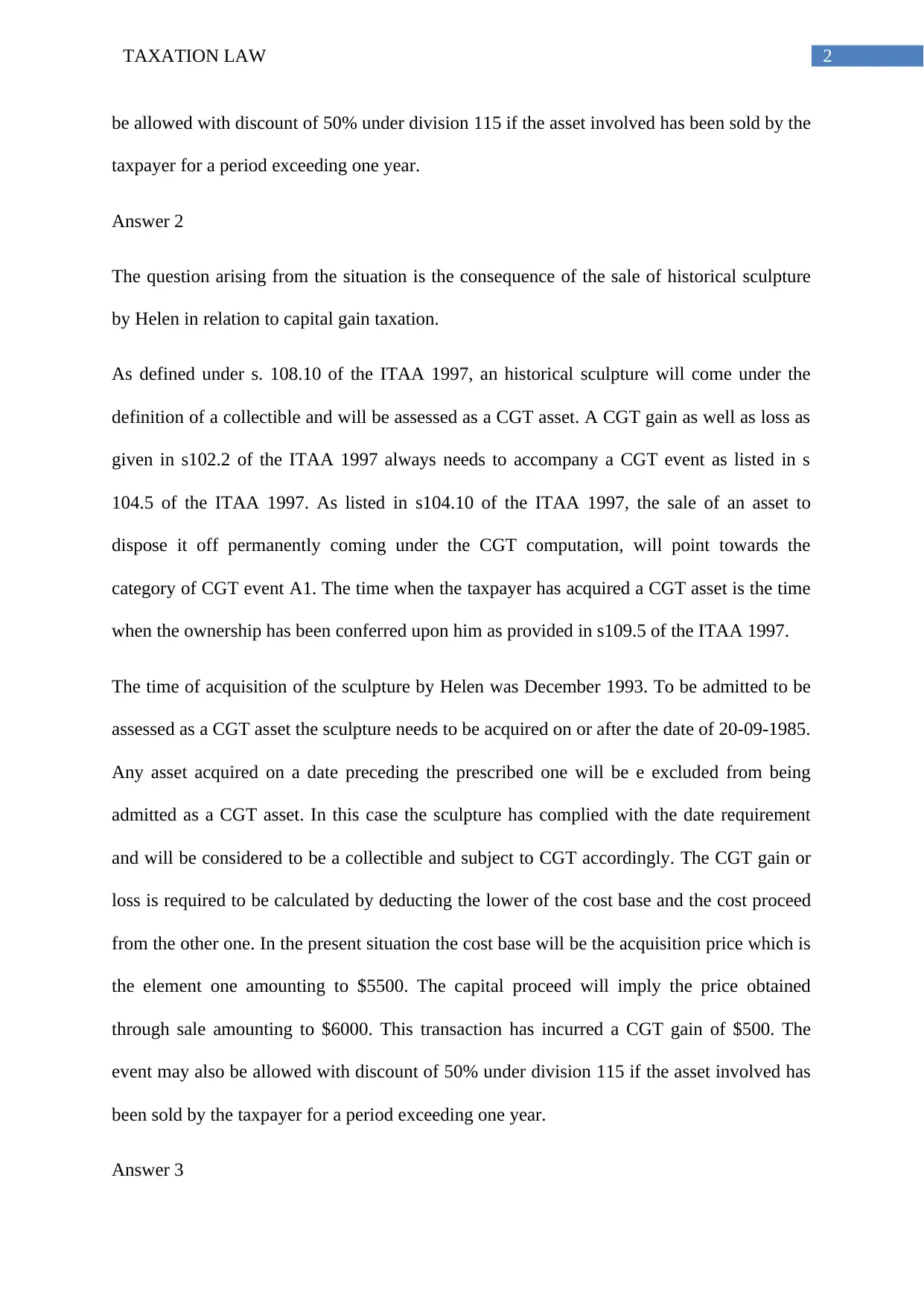
2TAXATION LAW
be allowed with discount of 50% under division 115 if the asset involved has been sold by the
taxpayer for a period exceeding one year.
Answer 2
The question arising from the situation is the consequence of the sale of historical sculpture
by Helen in relation to capital gain taxation.
As defined under s. 108.10 of the ITAA 1997, an historical sculpture will come under the
definition of a collectible and will be assessed as a CGT asset. A CGT gain as well as loss as
given in s102.2 of the ITAA 1997 always needs to accompany a CGT event as listed in s
104.5 of the ITAA 1997. As listed in s104.10 of the ITAA 1997, the sale of an asset to
dispose it off permanently coming under the CGT computation, will point towards the
category of CGT event A1. The time when the taxpayer has acquired a CGT asset is the time
when the ownership has been conferred upon him as provided in s109.5 of the ITAA 1997.
The time of acquisition of the sculpture by Helen was December 1993. To be admitted to be
assessed as a CGT asset the sculpture needs to be acquired on or after the date of 20-09-1985.
Any asset acquired on a date preceding the prescribed one will be e excluded from being
admitted as a CGT asset. In this case the sculpture has complied with the date requirement
and will be considered to be a collectible and subject to CGT accordingly. The CGT gain or
loss is required to be calculated by deducting the lower of the cost base and the cost proceed
from the other one. In the present situation the cost base will be the acquisition price which is
the element one amounting to $5500. The capital proceed will imply the price obtained
through sale amounting to $6000. This transaction has incurred a CGT gain of $500. The
event may also be allowed with discount of 50% under division 115 if the asset involved has
been sold by the taxpayer for a period exceeding one year.
Answer 3
be allowed with discount of 50% under division 115 if the asset involved has been sold by the
taxpayer for a period exceeding one year.
Answer 2
The question arising from the situation is the consequence of the sale of historical sculpture
by Helen in relation to capital gain taxation.
As defined under s. 108.10 of the ITAA 1997, an historical sculpture will come under the
definition of a collectible and will be assessed as a CGT asset. A CGT gain as well as loss as
given in s102.2 of the ITAA 1997 always needs to accompany a CGT event as listed in s
104.5 of the ITAA 1997. As listed in s104.10 of the ITAA 1997, the sale of an asset to
dispose it off permanently coming under the CGT computation, will point towards the
category of CGT event A1. The time when the taxpayer has acquired a CGT asset is the time
when the ownership has been conferred upon him as provided in s109.5 of the ITAA 1997.
The time of acquisition of the sculpture by Helen was December 1993. To be admitted to be
assessed as a CGT asset the sculpture needs to be acquired on or after the date of 20-09-1985.
Any asset acquired on a date preceding the prescribed one will be e excluded from being
admitted as a CGT asset. In this case the sculpture has complied with the date requirement
and will be considered to be a collectible and subject to CGT accordingly. The CGT gain or
loss is required to be calculated by deducting the lower of the cost base and the cost proceed
from the other one. In the present situation the cost base will be the acquisition price which is
the element one amounting to $5500. The capital proceed will imply the price obtained
through sale amounting to $6000. This transaction has incurred a CGT gain of $500. The
event may also be allowed with discount of 50% under division 115 if the asset involved has
been sold by the taxpayer for a period exceeding one year.
Answer 3
⊘ This is a preview!⊘
Do you want full access?
Subscribe today to unlock all pages.

Trusted by 1+ million students worldwide
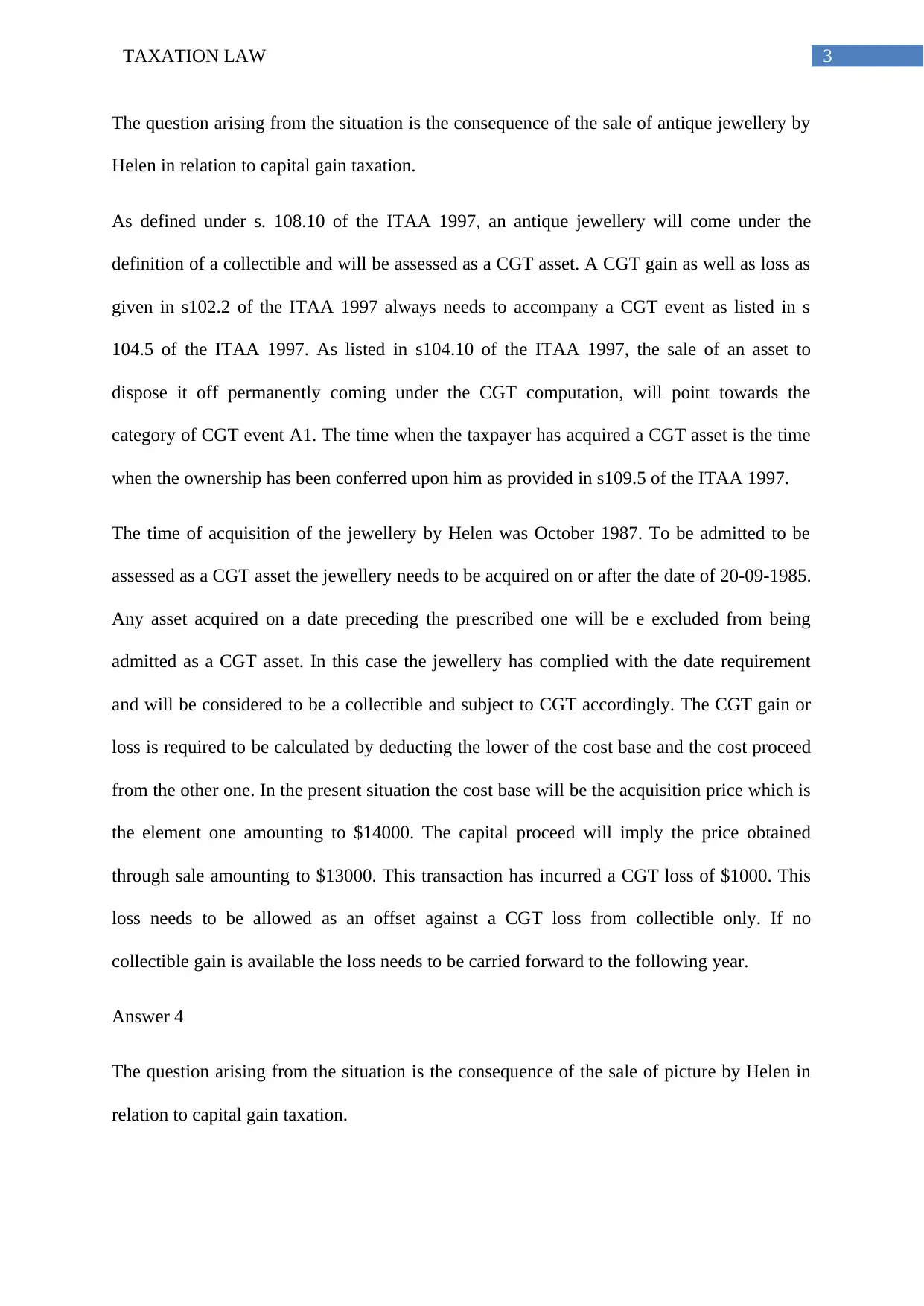
3TAXATION LAW
The question arising from the situation is the consequence of the sale of antique jewellery by
Helen in relation to capital gain taxation.
As defined under s. 108.10 of the ITAA 1997, an antique jewellery will come under the
definition of a collectible and will be assessed as a CGT asset. A CGT gain as well as loss as
given in s102.2 of the ITAA 1997 always needs to accompany a CGT event as listed in s
104.5 of the ITAA 1997. As listed in s104.10 of the ITAA 1997, the sale of an asset to
dispose it off permanently coming under the CGT computation, will point towards the
category of CGT event A1. The time when the taxpayer has acquired a CGT asset is the time
when the ownership has been conferred upon him as provided in s109.5 of the ITAA 1997.
The time of acquisition of the jewellery by Helen was October 1987. To be admitted to be
assessed as a CGT asset the jewellery needs to be acquired on or after the date of 20-09-1985.
Any asset acquired on a date preceding the prescribed one will be e excluded from being
admitted as a CGT asset. In this case the jewellery has complied with the date requirement
and will be considered to be a collectible and subject to CGT accordingly. The CGT gain or
loss is required to be calculated by deducting the lower of the cost base and the cost proceed
from the other one. In the present situation the cost base will be the acquisition price which is
the element one amounting to $14000. The capital proceed will imply the price obtained
through sale amounting to $13000. This transaction has incurred a CGT loss of $1000. This
loss needs to be allowed as an offset against a CGT loss from collectible only. If no
collectible gain is available the loss needs to be carried forward to the following year.
Answer 4
The question arising from the situation is the consequence of the sale of picture by Helen in
relation to capital gain taxation.
The question arising from the situation is the consequence of the sale of antique jewellery by
Helen in relation to capital gain taxation.
As defined under s. 108.10 of the ITAA 1997, an antique jewellery will come under the
definition of a collectible and will be assessed as a CGT asset. A CGT gain as well as loss as
given in s102.2 of the ITAA 1997 always needs to accompany a CGT event as listed in s
104.5 of the ITAA 1997. As listed in s104.10 of the ITAA 1997, the sale of an asset to
dispose it off permanently coming under the CGT computation, will point towards the
category of CGT event A1. The time when the taxpayer has acquired a CGT asset is the time
when the ownership has been conferred upon him as provided in s109.5 of the ITAA 1997.
The time of acquisition of the jewellery by Helen was October 1987. To be admitted to be
assessed as a CGT asset the jewellery needs to be acquired on or after the date of 20-09-1985.
Any asset acquired on a date preceding the prescribed one will be e excluded from being
admitted as a CGT asset. In this case the jewellery has complied with the date requirement
and will be considered to be a collectible and subject to CGT accordingly. The CGT gain or
loss is required to be calculated by deducting the lower of the cost base and the cost proceed
from the other one. In the present situation the cost base will be the acquisition price which is
the element one amounting to $14000. The capital proceed will imply the price obtained
through sale amounting to $13000. This transaction has incurred a CGT loss of $1000. This
loss needs to be allowed as an offset against a CGT loss from collectible only. If no
collectible gain is available the loss needs to be carried forward to the following year.
Answer 4
The question arising from the situation is the consequence of the sale of picture by Helen in
relation to capital gain taxation.
Paraphrase This Document
Need a fresh take? Get an instant paraphrase of this document with our AI Paraphraser
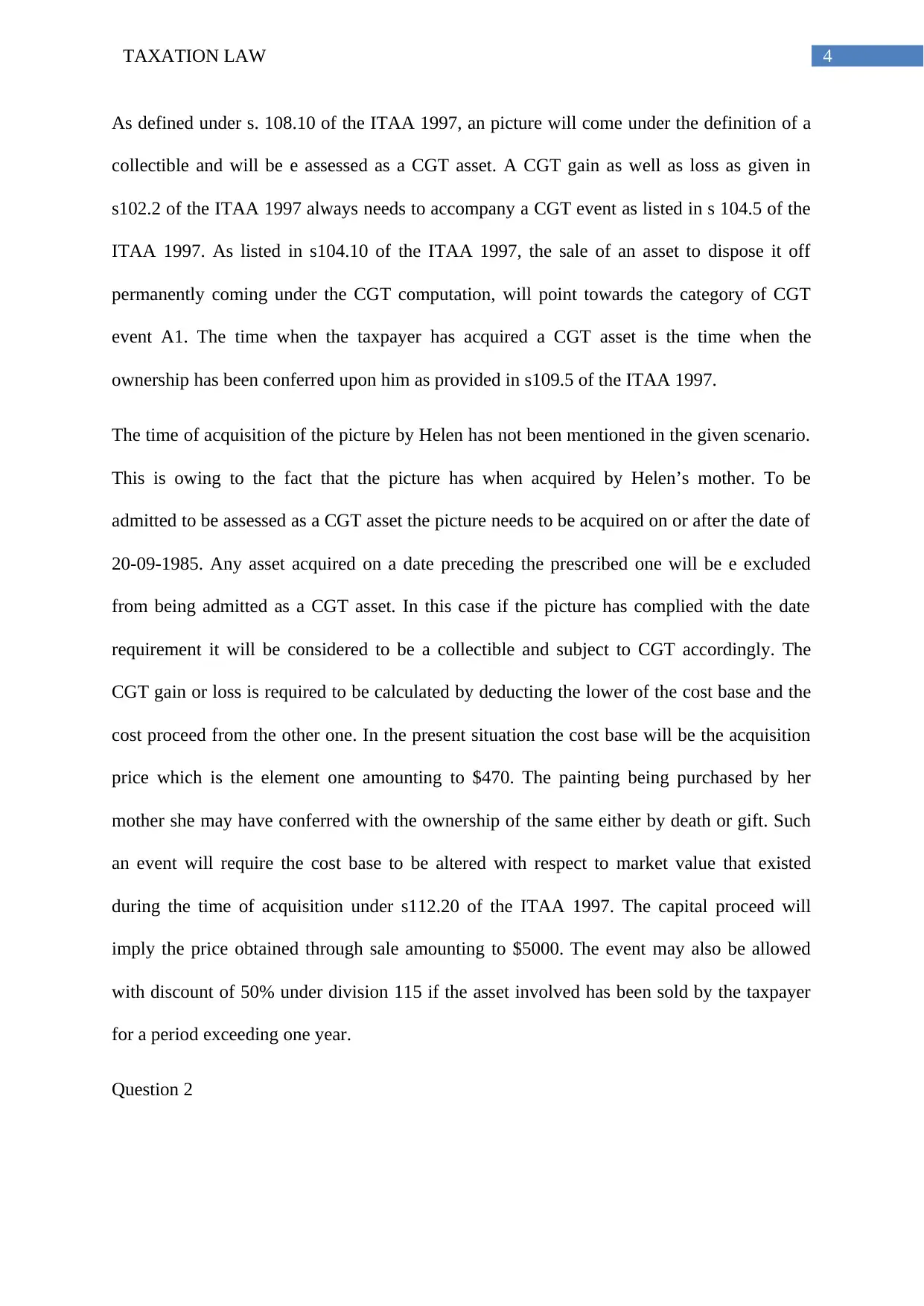
4TAXATION LAW
As defined under s. 108.10 of the ITAA 1997, an picture will come under the definition of a
collectible and will be e assessed as a CGT asset. A CGT gain as well as loss as given in
s102.2 of the ITAA 1997 always needs to accompany a CGT event as listed in s 104.5 of the
ITAA 1997. As listed in s104.10 of the ITAA 1997, the sale of an asset to dispose it off
permanently coming under the CGT computation, will point towards the category of CGT
event A1. The time when the taxpayer has acquired a CGT asset is the time when the
ownership has been conferred upon him as provided in s109.5 of the ITAA 1997.
The time of acquisition of the picture by Helen has not been mentioned in the given scenario.
This is owing to the fact that the picture has when acquired by Helen’s mother. To be
admitted to be assessed as a CGT asset the picture needs to be acquired on or after the date of
20-09-1985. Any asset acquired on a date preceding the prescribed one will be e excluded
from being admitted as a CGT asset. In this case if the picture has complied with the date
requirement it will be considered to be a collectible and subject to CGT accordingly. The
CGT gain or loss is required to be calculated by deducting the lower of the cost base and the
cost proceed from the other one. In the present situation the cost base will be the acquisition
price which is the element one amounting to $470. The painting being purchased by her
mother she may have conferred with the ownership of the same either by death or gift. Such
an event will require the cost base to be altered with respect to market value that existed
during the time of acquisition under s112.20 of the ITAA 1997. The capital proceed will
imply the price obtained through sale amounting to $5000. The event may also be allowed
with discount of 50% under division 115 if the asset involved has been sold by the taxpayer
for a period exceeding one year.
Question 2
As defined under s. 108.10 of the ITAA 1997, an picture will come under the definition of a
collectible and will be e assessed as a CGT asset. A CGT gain as well as loss as given in
s102.2 of the ITAA 1997 always needs to accompany a CGT event as listed in s 104.5 of the
ITAA 1997. As listed in s104.10 of the ITAA 1997, the sale of an asset to dispose it off
permanently coming under the CGT computation, will point towards the category of CGT
event A1. The time when the taxpayer has acquired a CGT asset is the time when the
ownership has been conferred upon him as provided in s109.5 of the ITAA 1997.
The time of acquisition of the picture by Helen has not been mentioned in the given scenario.
This is owing to the fact that the picture has when acquired by Helen’s mother. To be
admitted to be assessed as a CGT asset the picture needs to be acquired on or after the date of
20-09-1985. Any asset acquired on a date preceding the prescribed one will be e excluded
from being admitted as a CGT asset. In this case if the picture has complied with the date
requirement it will be considered to be a collectible and subject to CGT accordingly. The
CGT gain or loss is required to be calculated by deducting the lower of the cost base and the
cost proceed from the other one. In the present situation the cost base will be the acquisition
price which is the element one amounting to $470. The painting being purchased by her
mother she may have conferred with the ownership of the same either by death or gift. Such
an event will require the cost base to be altered with respect to market value that existed
during the time of acquisition under s112.20 of the ITAA 1997. The capital proceed will
imply the price obtained through sale amounting to $5000. The event may also be allowed
with discount of 50% under division 115 if the asset involved has been sold by the taxpayer
for a period exceeding one year.
Question 2
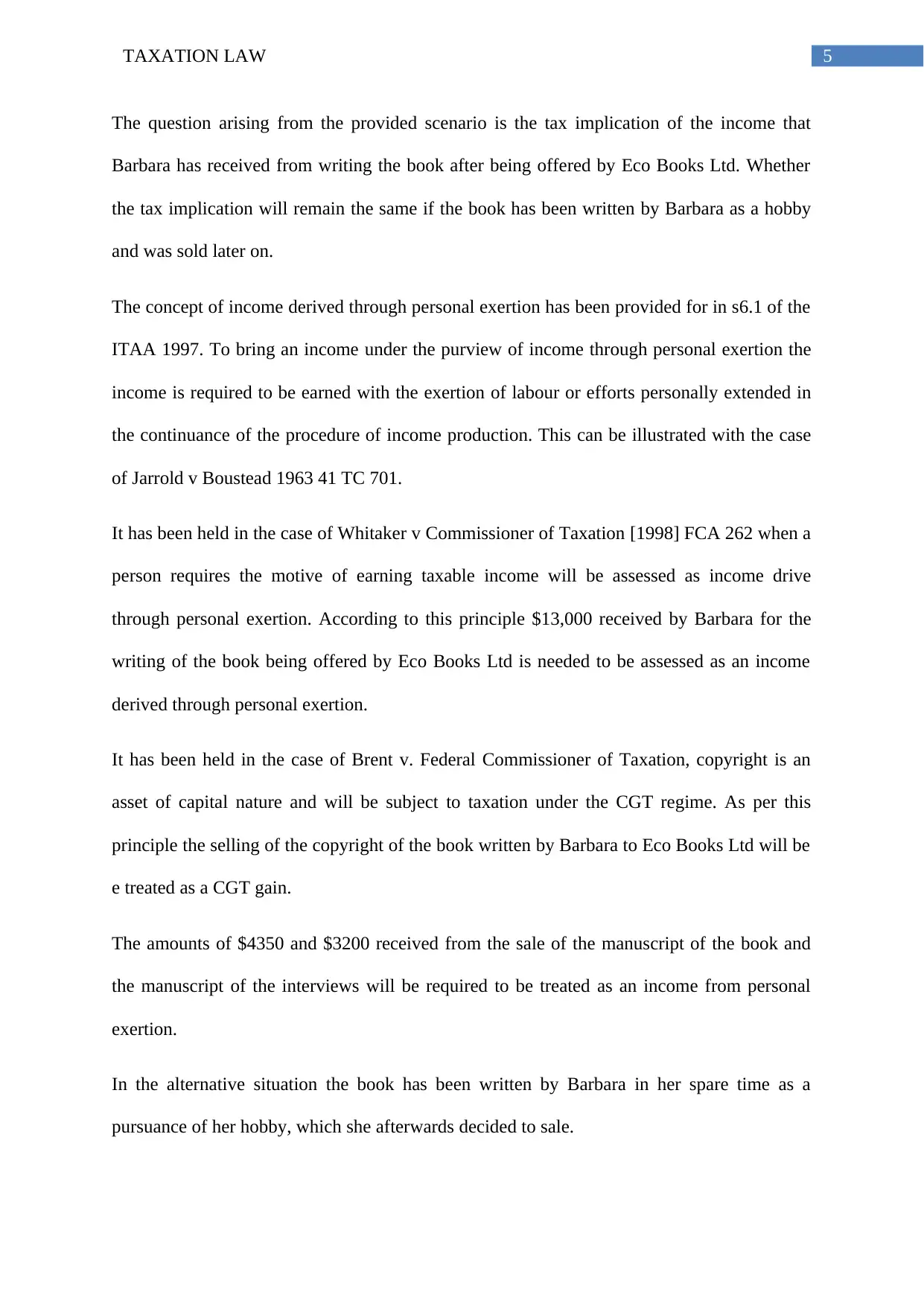
5TAXATION LAW
The question arising from the provided scenario is the tax implication of the income that
Barbara has received from writing the book after being offered by Eco Books Ltd. Whether
the tax implication will remain the same if the book has been written by Barbara as a hobby
and was sold later on.
The concept of income derived through personal exertion has been provided for in s6.1 of the
ITAA 1997. To bring an income under the purview of income through personal exertion the
income is required to be earned with the exertion of labour or efforts personally extended in
the continuance of the procedure of income production. This can be illustrated with the case
of Jarrold v Boustead 1963 41 TC 701.
It has been held in the case of Whitaker v Commissioner of Taxation [1998] FCA 262 when a
person requires the motive of earning taxable income will be assessed as income drive
through personal exertion. According to this principle $13,000 received by Barbara for the
writing of the book being offered by Eco Books Ltd is needed to be assessed as an income
derived through personal exertion.
It has been held in the case of Brent v. Federal Commissioner of Taxation, copyright is an
asset of capital nature and will be subject to taxation under the CGT regime. As per this
principle the selling of the copyright of the book written by Barbara to Eco Books Ltd will be
e treated as a CGT gain.
The amounts of $4350 and $3200 received from the sale of the manuscript of the book and
the manuscript of the interviews will be required to be treated as an income from personal
exertion.
In the alternative situation the book has been written by Barbara in her spare time as a
pursuance of her hobby, which she afterwards decided to sale.
The question arising from the provided scenario is the tax implication of the income that
Barbara has received from writing the book after being offered by Eco Books Ltd. Whether
the tax implication will remain the same if the book has been written by Barbara as a hobby
and was sold later on.
The concept of income derived through personal exertion has been provided for in s6.1 of the
ITAA 1997. To bring an income under the purview of income through personal exertion the
income is required to be earned with the exertion of labour or efforts personally extended in
the continuance of the procedure of income production. This can be illustrated with the case
of Jarrold v Boustead 1963 41 TC 701.
It has been held in the case of Whitaker v Commissioner of Taxation [1998] FCA 262 when a
person requires the motive of earning taxable income will be assessed as income drive
through personal exertion. According to this principle $13,000 received by Barbara for the
writing of the book being offered by Eco Books Ltd is needed to be assessed as an income
derived through personal exertion.
It has been held in the case of Brent v. Federal Commissioner of Taxation, copyright is an
asset of capital nature and will be subject to taxation under the CGT regime. As per this
principle the selling of the copyright of the book written by Barbara to Eco Books Ltd will be
e treated as a CGT gain.
The amounts of $4350 and $3200 received from the sale of the manuscript of the book and
the manuscript of the interviews will be required to be treated as an income from personal
exertion.
In the alternative situation the book has been written by Barbara in her spare time as a
pursuance of her hobby, which she afterwards decided to sale.
⊘ This is a preview!⊘
Do you want full access?
Subscribe today to unlock all pages.

Trusted by 1+ million students worldwide
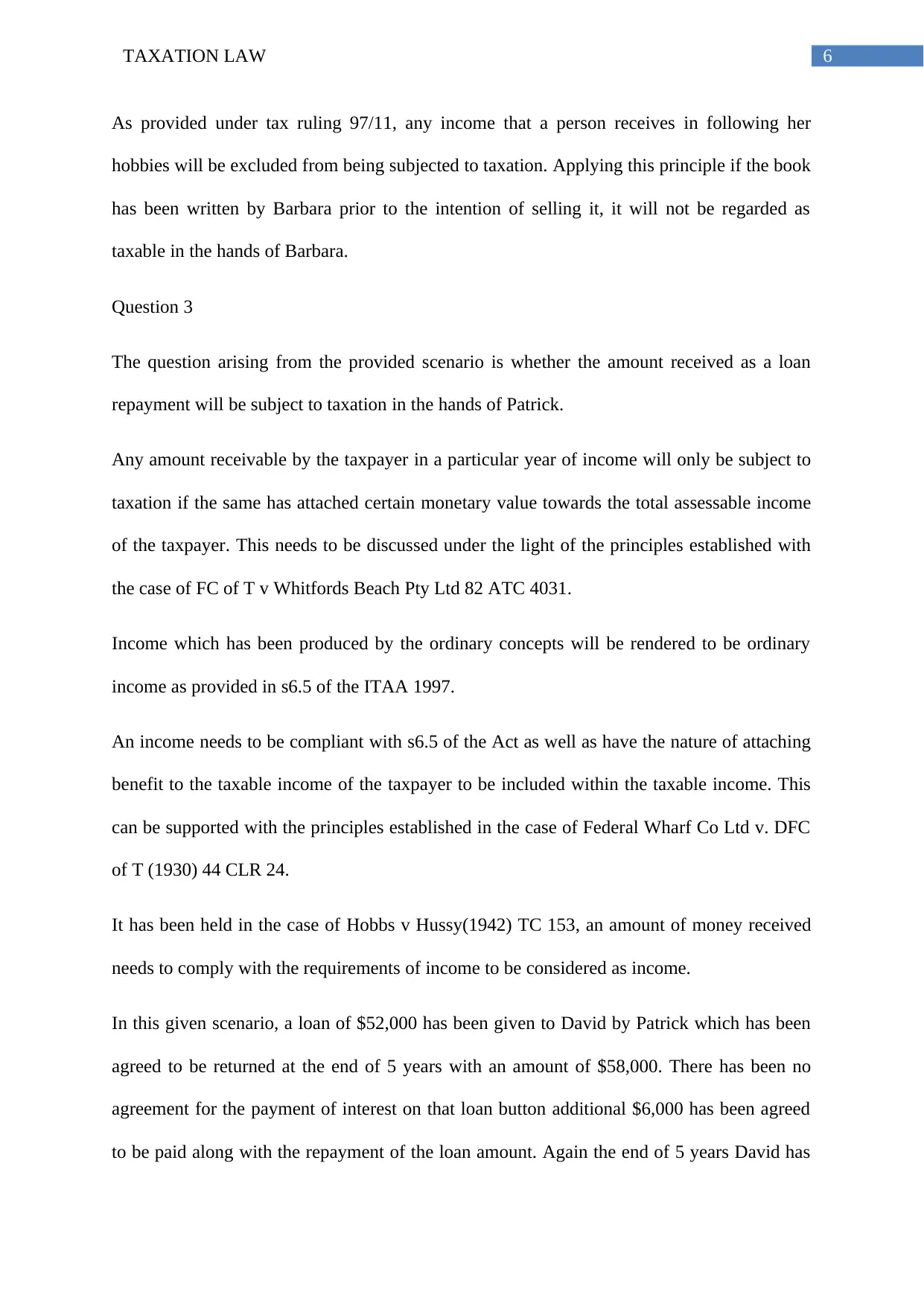
6TAXATION LAW
As provided under tax ruling 97/11, any income that a person receives in following her
hobbies will be excluded from being subjected to taxation. Applying this principle if the book
has been written by Barbara prior to the intention of selling it, it will not be regarded as
taxable in the hands of Barbara.
Question 3
The question arising from the provided scenario is whether the amount received as a loan
repayment will be subject to taxation in the hands of Patrick.
Any amount receivable by the taxpayer in a particular year of income will only be subject to
taxation if the same has attached certain monetary value towards the total assessable income
of the taxpayer. This needs to be discussed under the light of the principles established with
the case of FC of T v Whitfords Beach Pty Ltd 82 ATC 4031.
Income which has been produced by the ordinary concepts will be rendered to be ordinary
income as provided in s6.5 of the ITAA 1997.
An income needs to be compliant with s6.5 of the Act as well as have the nature of attaching
benefit to the taxable income of the taxpayer to be included within the taxable income. This
can be supported with the principles established in the case of Federal Wharf Co Ltd v. DFC
of T (1930) 44 CLR 24.
It has been held in the case of Hobbs v Hussy(1942) TC 153, an amount of money received
needs to comply with the requirements of income to be considered as income.
In this given scenario, a loan of $52,000 has been given to David by Patrick which has been
agreed to be returned at the end of 5 years with an amount of $58,000. There has been no
agreement for the payment of interest on that loan button additional $6,000 has been agreed
to be paid along with the repayment of the loan amount. Again the end of 5 years David has
As provided under tax ruling 97/11, any income that a person receives in following her
hobbies will be excluded from being subjected to taxation. Applying this principle if the book
has been written by Barbara prior to the intention of selling it, it will not be regarded as
taxable in the hands of Barbara.
Question 3
The question arising from the provided scenario is whether the amount received as a loan
repayment will be subject to taxation in the hands of Patrick.
Any amount receivable by the taxpayer in a particular year of income will only be subject to
taxation if the same has attached certain monetary value towards the total assessable income
of the taxpayer. This needs to be discussed under the light of the principles established with
the case of FC of T v Whitfords Beach Pty Ltd 82 ATC 4031.
Income which has been produced by the ordinary concepts will be rendered to be ordinary
income as provided in s6.5 of the ITAA 1997.
An income needs to be compliant with s6.5 of the Act as well as have the nature of attaching
benefit to the taxable income of the taxpayer to be included within the taxable income. This
can be supported with the principles established in the case of Federal Wharf Co Ltd v. DFC
of T (1930) 44 CLR 24.
It has been held in the case of Hobbs v Hussy(1942) TC 153, an amount of money received
needs to comply with the requirements of income to be considered as income.
In this given scenario, a loan of $52,000 has been given to David by Patrick which has been
agreed to be returned at the end of 5 years with an amount of $58,000. There has been no
agreement for the payment of interest on that loan button additional $6,000 has been agreed
to be paid along with the repayment of the loan amount. Again the end of 5 years David has
Paraphrase This Document
Need a fresh take? Get an instant paraphrase of this document with our AI Paraphraser
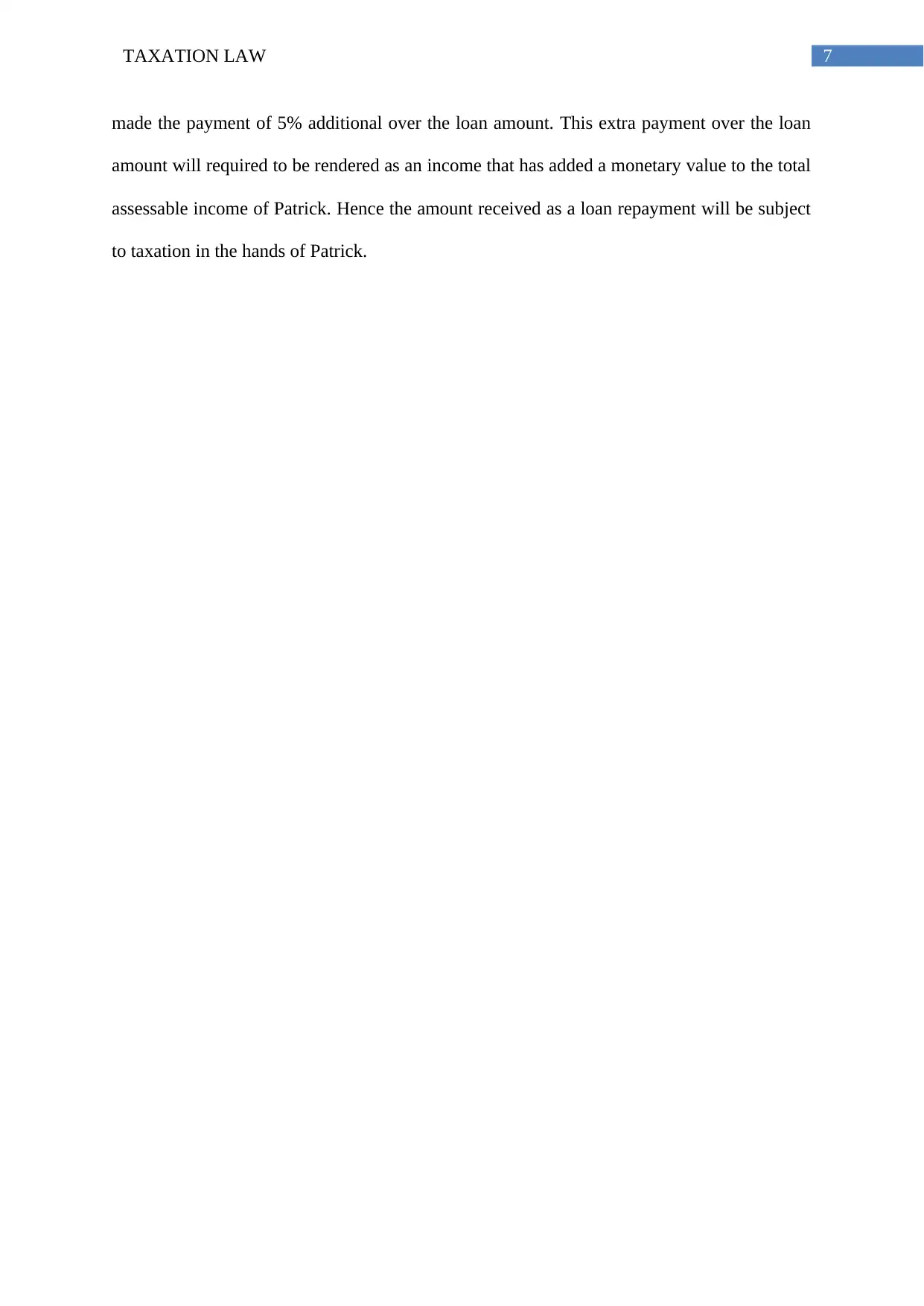
7TAXATION LAW
made the payment of 5% additional over the loan amount. This extra payment over the loan
amount will required to be rendered as an income that has added a monetary value to the total
assessable income of Patrick. Hence the amount received as a loan repayment will be subject
to taxation in the hands of Patrick.
made the payment of 5% additional over the loan amount. This extra payment over the loan
amount will required to be rendered as an income that has added a monetary value to the total
assessable income of Patrick. Hence the amount received as a loan repayment will be subject
to taxation in the hands of Patrick.
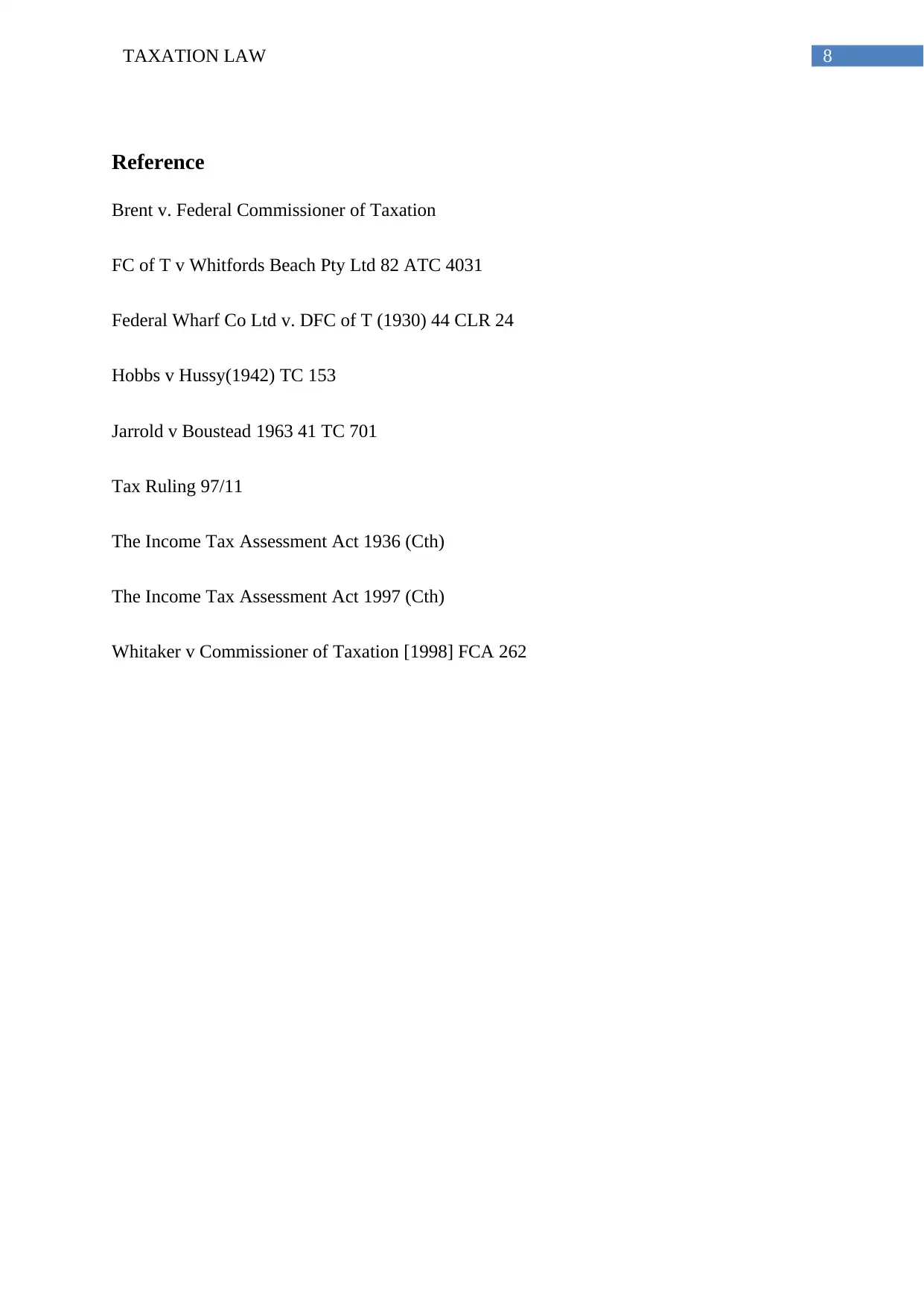
8TAXATION LAW
Reference
Brent v. Federal Commissioner of Taxation
FC of T v Whitfords Beach Pty Ltd 82 ATC 4031
Federal Wharf Co Ltd v. DFC of T (1930) 44 CLR 24
Hobbs v Hussy(1942) TC 153
Jarrold v Boustead 1963 41 TC 701
Tax Ruling 97/11
The Income Tax Assessment Act 1936 (Cth)
The Income Tax Assessment Act 1997 (Cth)
Whitaker v Commissioner of Taxation [1998] FCA 262
Reference
Brent v. Federal Commissioner of Taxation
FC of T v Whitfords Beach Pty Ltd 82 ATC 4031
Federal Wharf Co Ltd v. DFC of T (1930) 44 CLR 24
Hobbs v Hussy(1942) TC 153
Jarrold v Boustead 1963 41 TC 701
Tax Ruling 97/11
The Income Tax Assessment Act 1936 (Cth)
The Income Tax Assessment Act 1997 (Cth)
Whitaker v Commissioner of Taxation [1998] FCA 262
⊘ This is a preview!⊘
Do you want full access?
Subscribe today to unlock all pages.

Trusted by 1+ million students worldwide
1 out of 9
Related Documents
Your All-in-One AI-Powered Toolkit for Academic Success.
+13062052269
info@desklib.com
Available 24*7 on WhatsApp / Email
![[object Object]](/_next/static/media/star-bottom.7253800d.svg)
Unlock your academic potential
Copyright © 2020–2025 A2Z Services. All Rights Reserved. Developed and managed by ZUCOL.





